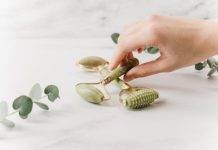Going natural is slowly becoming more popular as the Euro-centric myth of “good hair” slowly fades out of existence. However, many women have only ever learned how to care for straightened or relaxed hair, making the process of maintaining and caring for natural hair stressful and frustrating. Here are 3 tips to keep your curls fresh and stress-free – without the use of chemicals or heat.
- Lose the Brush – Yesterday.
Never ever, ever, ever use a brush on naturally curly hair. Ever. On a micro-level, brushes are notorious for breaking hair, making the inevitable frizz and split ends unbelievably worse. On the macro-scale, brushes disrupt the natural shape of curls, giving you that uncomfortable in-between straight and curly look. Instead, detangle in the shower before you rinse out your conditioner – starting at the bottom of your hair and working your way up to the roots – and use a leave-in conditioner to keep your curls sleek until your next washday. And on the subject of leave-in conditioner –
- Coconut Oil.
I know every Pinterest hippie and her earth mother have jumped aboard the coconut oil train for everything from curing heart disease to balancing your checkbooks, but coconut oil is the real deal when it comes to moisturizing dry, curly hair. For generations, women in the Caribbean have been using coconut oil to keep their hair healthy and soft, long before the current health craze over it began. After washing, work a small amount through your hair and let it air dry to set your curls. If you need an instant-frizz fix in the middle of the week, dampen the trouble spots with a few spritzes of water and work an even smaller amount through – it’s easy to go overboard with straight oil.
- Silk or Satin Pillowcases and Headscarves.

Cotton and other fabrics commonly used to make pillowcases soak up moisture are rough on curls, causing hair strands to break, split, and knot when you move around in your sleep. Silk, on the other hand, is smooth and non-porous, allowing hair to move across it without breaking and retain moisture. Silk can be expensive, though, so higher-quality satin fabrics, such as charmeuse satin, is a great alternative. Wrapping your hair in silk or satin headscarves will also help you lock in moisture, and you’ll look rockin’ while you do.

![5 Reasons You Should Travel Alone Airplane [image source: chau nguyen/ http://thedevilhatessweatpants.blogspot.com.au ], crowd ink, crowdink, crowdink.com, crowdink.com.au](https://crowdink.com/wp-content/uploads/2016/08/Chau-airplane-218x150.jpg)




























![5 Reasons You Should Travel Alone Airplane [image source: chau nguyen/ http://thedevilhatessweatpants.blogspot.com.au ], crowd ink, crowdink, crowdink.com, crowdink.com.au](https://crowdink.com/wp-content/uploads/2016/08/Chau-airplane-100x70.jpg)


